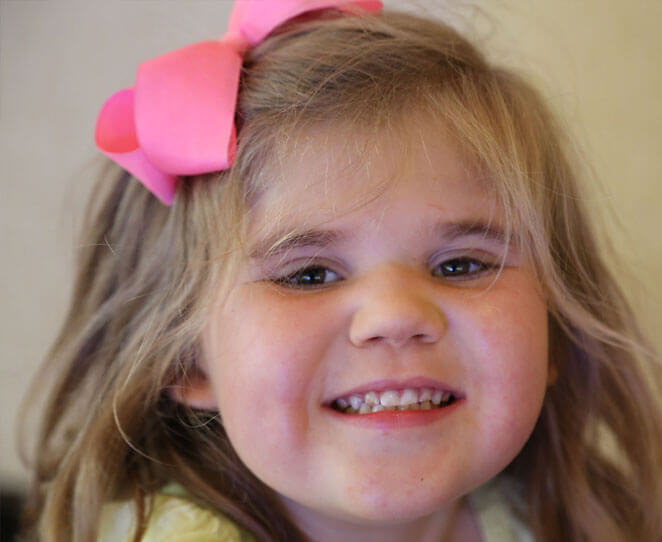Smith-Magenis Syndrome
Smith-Magenis Syndrome (SMS) is a rare neurobehavioral disorder characterized by a recognizable pattern of physical, behavioral, and developmental features. It is caused by particular genetic changes on chromosomal region 17p11.2, which contains the gene RAI1.
Incidence
SMS is a rare disorder that occurs in between 1 out of every 15,000 to 25,000 births. Although the number of individuals diagnosed with SMS has increased in recent years due to better diagnostic tools, the syndrome likely remains under diagnosed.
Your participation in PRISMS SMS Patient Registry will help us achieve a more accurate understanding of the incidence rate.

Common features include:
- Developmental delay/intellectual disability
- Hypotonia (low muscle tone)
- Poor gross motor and fine motor skills
- Feeding problems in infancy (poor suck/swallow); failure to thrive or difficulty gaining weight (<3 years)
- Speech delay
- Characteristic facial appearance (broad forehead, down-turned “tent”-shaped upper lip vermilion, short upturned nose)
- Short fingers and toes
- Distinct, broad-based gait (style of walking)
- Scoliosis (abnormal curvature of the spine)
- Vision problems (strabismus; nearsightedness)
- Middle ear abnormalities, chronic ear infections
- Hearing impairment
- Hoarse, deep, sometimes nasal voice
- Decreased sensitivity to pain; hypersensitivity
- Constipation
- Sleep disturbance (frequent nighttime awakenings; daytime sleepiness)
- Self-injurious behaviors
- Prolonged tantrums, explosive outbursts, impulsivity
- Arm hugging/hand squeezing
- Endearing and engaging personalities
- Excellent long-term memory for names, places, events
- Great sense of humor
- Eagerness to please and sensitivity towards others
Diagnosis
The diagnosis of Smith-Magenis Syndrome (SMS) is usually confirmed through a clinical blood test called a chromosome analysis. Diagnosis can also be made through a cytogenetic test and FISH (fluorescence in situ hybridization) or by chromosome microarray analysis (CGH).
Most people diagnosed with SMS are born with a small deletion of one member of their 17th pair of chromosomes. It is the lack of this specific section, known as 17p11.2, which causes the features of SMS.
The genes commonly deleted in persons with SMS have been narrowed to a “critical region” encompassing approximately 25 genes. All deletion cases include deletion of the RAI1 gene.
In cases where a deletion is not detected, sequencing of the RAI1 gene should be considered. Approximately 90% of the cases of SMS are due to deletion, with the remaining 10% due to a mutation that occurs within the RAI1 gene.
Mutations in RAI1 can be identified by sequencing of the RAI1 gene. Sequencing of RAI1 can be done by different types of genetic tests. Tests that include RAI1 sequencing:
- Whole Exome Sequencing: this test sequences all of an individual’s genes
- Panel Genetic Testing: this test includes sequencing for only a select number of genes. RAI1 must be listed as a gene in the panel. Panels for seizures, autism spectrum disorder and/or intellectual disability typically include RAI1
- RAI1 sequencing: this test sequences only RAI1
Although SMS is caused by a deletion of genetic material, it usually does not run in families. In most cases, the deletion occurs accidentally in a child around the time he or she is conceived, without being inherited from either parent. For this reason, we can say that SMS is clearly genetic, but not usually familial.
Families are advised to consult a genetic counselor or specialist for further advice regarding their own particular family situation. If you need help finding a genetic counselor in your area, please see the National Society of Genetic Counselors’ online directory.
In-Depth Review
PRISMS Professional Advisory Board has written an in-depth review of Smith-Magenis Syndrome (SMS). This review is published at GeneReviews, a medical genetics resource for physicians, health care providers and researchers. GeneReviews is funded by the National Institutes of Health and developed at the University of Washington, Seattle.


